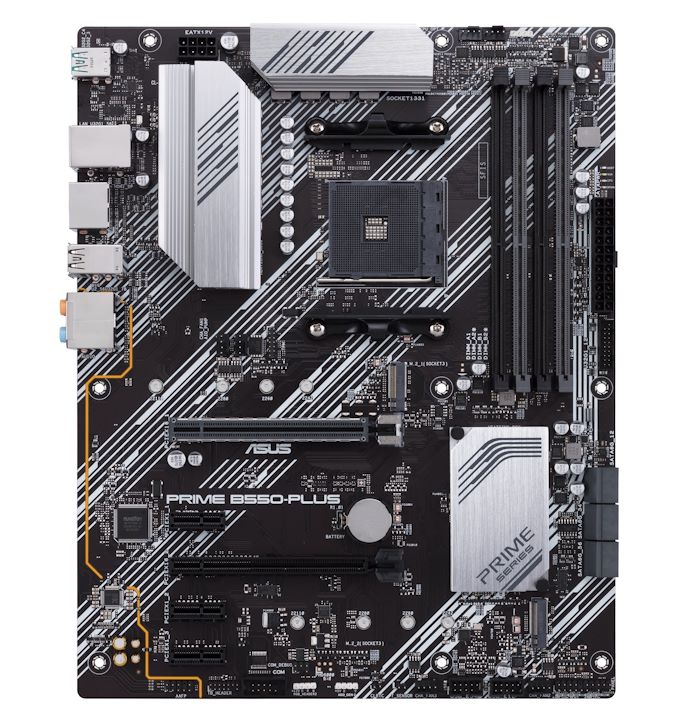The AMD B550 Motherboard Overview: ASUS, GIGABYTE, MSI, ASRock, and Others
by Dr. Ian Cutress & Gavin Bonshor on June 16, 2020 11:00 AM ESTASUS Prime B550-Plus
The Prime line of motherboards now sits as ASUS’ budget line, as an entry point into the market. The focus of Prime is on a simple polished aesthetic, which is why we’re going to see a good amount of polished metal designs, and in the case of the ASUS Prime B550-Plus, the white lines on the motherboard this time go from top right to bottom left.
It’s good to see we still have multiple power delivery heatsinks here, even if they’re not connected by a heatpipe, but the design across the PCB carries over across the heatsink in order to keep the continuity. The CPU is powered by a single 8-pin to the top left, and the socket has access to four 4-pin headers within easy reach.
The memory slots are again single sided latch designs, despite the main PCIe slot being further way than usual. On the right hand side of the board is a 24-pin ATX power connector, a USB 3.0 header, and six SATA ports.
For the PCIe layout, at the top is the PCIe 4.0 x4 M.2 slot, without a heatsink cover. Next is the PCIe 4.0 x16 full-length slot, with additional reinforcement. The board also has a full-length PCIe 3.0 x4 slot from the chipset, and below the chipset heatsink is a PCIe 3.0 x4 M.2 slot, also without a heatsink.
ASUS’ Prime boards use ALC887 audio codecs rather than the S1200A custom ones, but here we get some PCB separation in built in LEDs as well. Along the bottom of the board there is a Thunderbolt header, a COM header, RGB LED headers, a Clear CMOS header, a thermocouple header, two additional 4-pin fan headers, and two USB 2.0 headers.
On the rear panel there is a USB 3.2 Gen 2 Type-A port, a USB 3.2 Gen 2 Type-C port, a gigabit Ethernet port (Realtek RTL8111H), four USB 3.2 Gen 1 ports, a DisplayPort, a HDMI video output, two USB 2.0 ports, and the audio jacks.












101 Comments
View All Comments
Operandi - Tuesday, June 16, 2020 - link
Looks like some nice mATX versions this round, nice!YB1064 - Thursday, June 18, 2020 - link
I was hoping to see a $75-$90 board.kenjiwing - Tuesday, June 16, 2020 - link
Fortunately, this component is a unique motherboard among B550 and well worth reading up on [add link].Needs to be edited.
anirudhs - Tuesday, June 16, 2020 - link
There's a noise sensor which can adjust fan speed for maximum quietness with good thermals. Saw it on the KitGuruTech video. The noise sensor isn't there to spy on you though.PeterCollier - Wednesday, June 17, 2020 - link
The quality of the editing here is shit tier. Seriously, just run the articles through Grammarly before publication. It's free and it spots plenty of errors.Heavenly71 - Tuesday, June 16, 2020 - link
Sadly none of the mITX boards have more than 6 external USB ports. My old ASUS mITX has 8! And in really small mITX cases you can't add a bracket with more USB, because the two brackets are already used by the gfx card. Guess I have to wait for an enthusiast mITX board )-:damianrobertjones - Tuesday, June 16, 2020 - link
Or, just maybe, get a usb dongle with 4 ports?Mr Perfect - Tuesday, June 16, 2020 - link
That is disappointing. The number of USB devices people need to plug in can't be dropping, surely? I know I've got more now then even a year ago.rrinker - Tuesday, June 16, 2020 - link
Are they really going up? I have 2 USB devices plugged in to my system - a keyboard and a mouse. I occasionally plug a USB stick in one of the front ports to transfer files. My phone and tablet sync over wifi, they don't get plugged in. I have a charger behind my desk and a cable to charge them. My printer is on the network.The one place I DO need lots of USB ports is also the place where I have a small cube case machine, with no discreete GPU, because it doesn;t need one. On that one I added a USB PCI card to get enough ports. In addition to the keyboard and mouse, that machine is on my workbench where it connects to several electronic test instruments and I have multiple cabled for programming microcontrollers. I also have a USB microscope for board inspection. And then I have 3 more USB devices connected for my other hobby that shares the bench. Plus a front port kept free for USB sticks.
So the use case I have for more USB has the PCI slots open to add expansion cards, the use case where I have a discrete GPU eating up the slot space doesn't need an excess of USB ports.
DigitalFreak - Tuesday, June 16, 2020 - link
I use 3 USB 3.0 ports just for my Oculus Rift